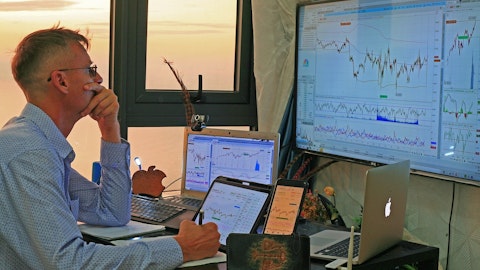Edward Decker: Yes, Steven, for that, we’re always looking at a balance between ticket and transactions. And what was interesting during the COVID period, we had inflation. So we had AUR up and we had ticket up, also driven by basket size. But the engagement was so high, you really didn’t have elasticities. You had driving ticket in transactions, and that’s what led to the 25% comp. As inflation has abated in primarily commodities and those prices have come down, you’ve seen a falloff in ticket. And you didn’t get the elasticity initially that you’d expect, and that was because people were still powering through projects. And now it’s a mix of what’s the level of response from pricing versus pull forward versus the Fed stance and higher interest rates.
So that’s all the dynamic that it’s muddying the traditional ticket and transaction dynamic. But what’s healthy for us is a solid comp equally balanced between ticket and transactions. And that’s what we’d be looking for. And now as we’ve said, prices have essentially leveled. Our ticket was down modestly. And if you take out commodity, our ticket would have been up for the quarter. And then transactions, we’re still working through a bit of that PCE shift pull forward, whatever that dynamic might be. But we’d be looking for growth in each in a nice balance going forward.
Operator: Our next question comes from the line of Brian Nagel with Oppenheimer.
Brian Nagel: The question I have, I think Michael may have asked previously just about price actions, but I guess maybe to expand that a bit further. So we’ve been discussing now this trend and weakness in bigger tickets for a while. I mean, obviously, a very unique demand backdrop. But again, from your perspective, particularly as you look towards ’24, are there other levers that Home Depot could pull to potentially spur better demand within big-ticket other than price?
Edward Decker: Well, the number one way that we’re focused to drive demand is with the complex Pro. So it’s — that is our key strategy and that’s what we’re focused on. It’s a $200 billion space as we’ve defined the $950 billion split evenly pro and consumer. And if the $475 billion that’s Pro, there’s $200 billion that is larger pros, more complex spend that we’re building out the capabilities to serve that demand. And that, Brian, is what we’re very, very focused on and I think for years and years, that is going to be a driver of our business as we take share in that sort of $200 billion white space.
Brian Nagel: Thanks, Ted. Got it. And then my second — my follow-up, much quicker. Obviously, you narrowed your guidance for the balance of the year. You talked about trends in the fiscal third quarter. But any commentary on sales trends early here in fiscal Q4?
Richard McPhail: Our performance in the first 2 weeks is on track to achieve our full year 2023 guidance.
Operator: Our next question comes from the line of Peter Benedict with Baird.
Peter Benedict: Another one on average ticket here. So pre-COVID average ticket around $67. I think now it’s kind of trending closer to $90, so up 35%. Richard, I just wonder if you have any perspective on kind of the like-for-like SKU inflation component there versus the big-ticket mix? It sounds like your like-for-like inflation is — seems to be stabilizing. I know there’s innovation that can make things not like-for-like. But just curious, as you think about the big-ticket exposure there and what could potentially play out there? How big of a deal is that?
Richard McPhail: Thanks for the question. I think there are a few answers to that. First of all, we have seen inflation abate and really kind of settle on a like-for-like basis across the portfolio. I think it’s interesting you see some — we’ve seen different dynamics in big-ticket over the years as we’ve had lumber inflation and deflation, in particular, skewing those results in big ticket. But Billy, maybe you talk a little bit about trends there.
William Bastek: Yes. I mean — and I’ll just — Ted’s response back to Brian on you see categories like drywall where we have capabilities, roofing, insulation, portable power where we’ve added innovation, we continue to see great both Pro and consumer reaction to just the innovation and things we’re seeing. As it relates to big-ticket, obviously, you’ve seen some deferral and so forth, as we talked about. Certainly, the pull forward is probably still playing a part in that as we continue to get further away from the pandemic. So we’ll watch that closely. We don’t see anything. As I mentioned, stabilized pricing, rational environment and we don’t see anything different from what we’ve seen over the last multiple months now.
Peter Benedict: Okay. Thanks for that guide. And then I just — I guess, turning to maybe the leverage and the pace of buyback. And if we stay in this environment of, let’s call it, moderation in demand, how do you think about just maybe balancing your buyback approach leverage? I mean, you’re still operating below the 2x. Is there anything that prevents you from kind of moving up to that 2x? Are you — just kind of curious on your latest thoughts around those topics.





